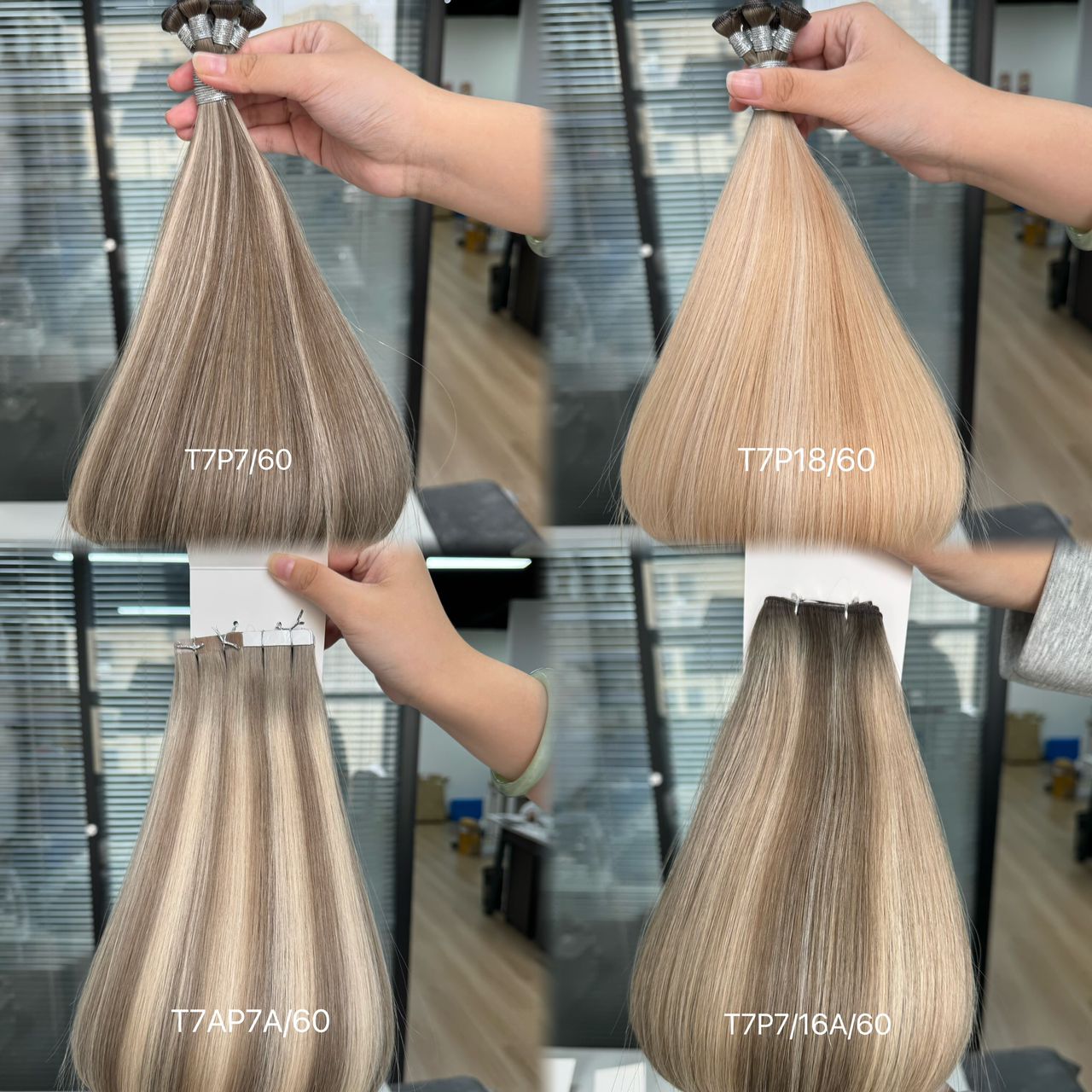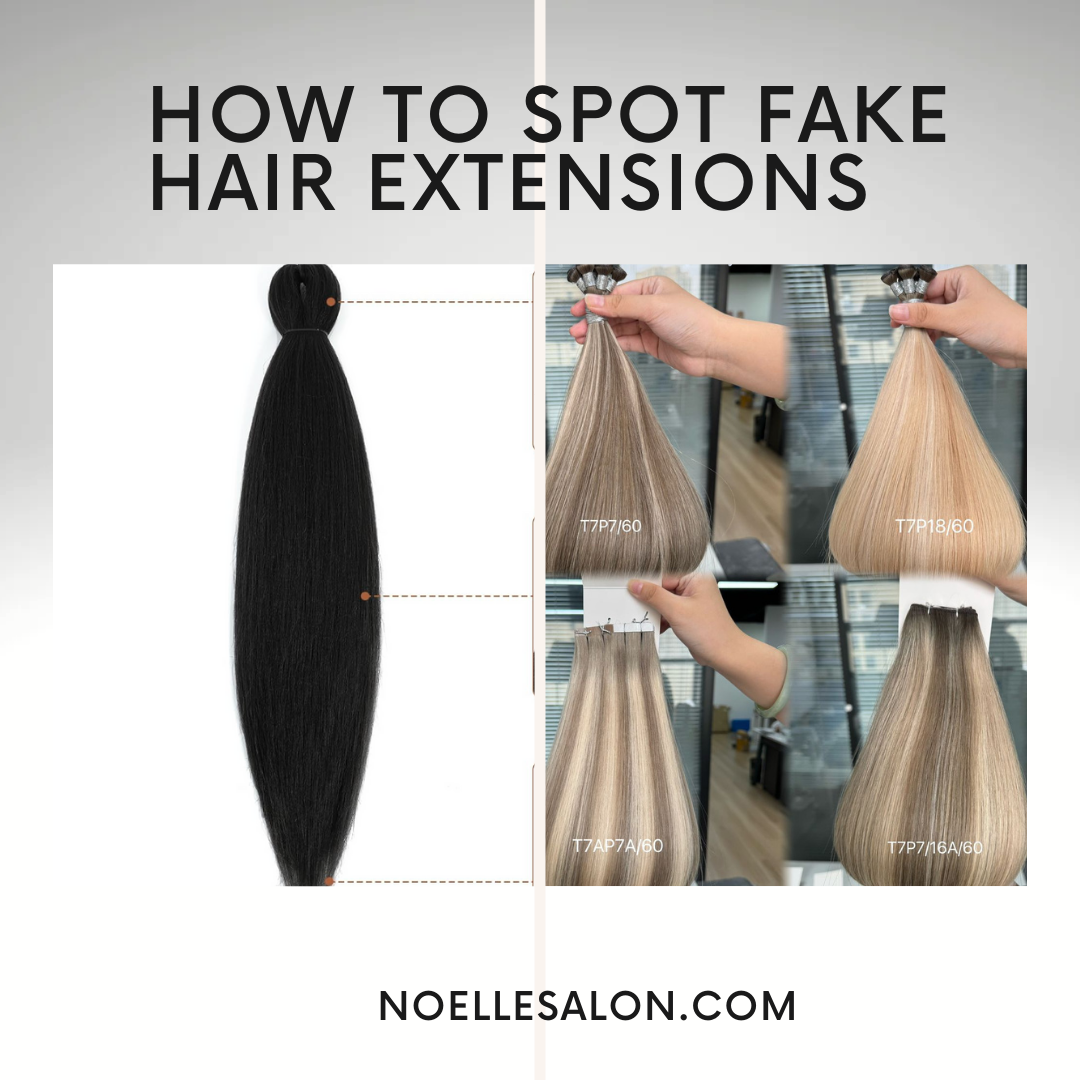Easy Guide: How to Spot Fake Hair Extensions

Key Highlights
The demand for hair extensions has skyrocketed, leading to a rise in counterfeit products.
- This blog post will equip you with the knowledge to differentiate between real and fake hair extensions.
- We will discuss simple initial checks like texture analysis and the cuticle resistance method.
- Further, we will explore advanced techniques such as the burn test and the water test.
- By understanding these techniques, you can ensure that you're investing in genuine hair extensions that enhance your natural beauty while keeping your hair healthy.
Introduction
In recent years, many people have started using both synthetic hair and human hair extensions. These extensions are a great way to get longer and fuller hair, providing a more natural look. However, as more people want these products, fake hair extensions are becoming common. These fake extensions are usually made from cheap synthetic fibers or heavily processed human hair. They can harm your natural hair and often do not give you the results you want. Therefore, it is very important to know how to tell real extensions from fake ones.
Understanding Hair Extensions: Know Your Basics

Hair extensions are made to help you have longer, fuller, and more glamorous hair. There are different kinds available. The two most common types are human hair extensions and synthetic hair extensions. Although they both aim to improve your hair, they are quite different in quality, look, care, and price. Knowing these differences will help you choose wisely.
By learning about real human hair extensions, wigs, and synthetic ones, you can make smart choices when you buy. Now, let’s look at the main differences between human hair and synthetic hair.
The Difference Between Human and Synthetic Hair
Real human hair extensions are made from hair taken from donors. This makes them a perfect match to your own hair. Since they are natural, they look and feel authentic. You can style them in many ways, just like your own hair, showcasing their styling versatility. You can curl, straighten, or color them.
In contrast, synthetic hair extensions are made from fibers like nylon or polyester. They are designed to look like real hair, making them an attractive option for those seeking budget-friendly alternatives. While they have improved in appearance, they still often lack the texture, movement, and shine of real human hair.
Knowing this key difference helps you understand what makes good hair extensions stand out from fake ones. Understanding these differences helps you make smart choices about which extensions to choose.
Key Characteristics of Quality Hair Extensions
Quality hair extensions, especially real human hair extensions, have some key traits. First, they have a natural shine and soft feel that looks a lot like your own hair. This natural look, movement, and natural texture are hard to imitate with synthetic hair.
Virgin Remy hair extensions are known as a sign of good quality in real human hair. They come from careful sourcing, keeping the hair cuticles aligned in the same direction, from root to tip. This careful process helps reduce tangling and matting. The result is extensions that appear healthy and smooth.
Additionally, quality hair extensions are known for their durability. If you take good care of them, they can last for many months. This makes them a smart investment. Knowing these signs of quality helps you spot real extensions from those that try to look premium but aren't.
Initial Examination: Spotting the Fakes Early
Before you start using more advanced ways to identify hair extensions, there are some easy checks you can do to find fakes. These simple tests can give you quick clues about whether the type of hair extensions are real or not.
Having a careful look and touching the hair can really help you decide better. Remember, spotting fakes early can save you from being disappointed later and helps make sure your investment is smart.
Texture and Feel Test
The first and easiest way to check is by feeling the texture of the hair. Real human hair has a special feel. It's soft, smooth, and has a little natural roughness. If you run your fingers through it, you will find slight changes in thickness, just like real hair.
On the other hand, synthetic hair extensions often feel too smooth and shiny. They might even feel a bit "plastic-like" or too "perfect" when you touch them. This smoothness may look nice, but it is a sign of fake fibers.
Next, look at how the hair falls. Natural hair flows and bounces well, while synthetic hair usually looks stiff and doesn't drape naturally. By noticing these small differences, you can learn more about the authenticity of the hair extensions.
The Cuticle Resistance Method
Another easy method to help you differentiate between real and synthetic hair is the cuticle resistance test. This simple technique involves gently running your fingers up and down a strand of hair to assess its smoothness.
Real hair, with its intact cuticles, will exhibit slight resistance when you run your fingers upwards due to the natural scales on the hair shaft. Synthetic hair, however, typically lacks these cuticles, making it smooth in both directions.
|
Hair Type |
Resistance When Stroked Upwards |
Resistance When Stroked Downwards |
|
Real Hair |
Slight Resistance |
Smooth |
|
Synthetic Hair |
Smooth |
Smooth |
This difference in resistance can be a clear indicator of whether you're dealing with real hair extensions or their synthetic counterparts.
Advanced Techniques to Identify Fake Hair Extensions
If the first check makes you feel uncertain, there are other methods that can help you confirm if the hair extensions are real. These methods can give you clearer answers, especially when you want to be sure about the quality of the hair and the quality of the hair extensions.
Even though these methods might take a bit more work, they can give you comfort when buying hair extensions. Keep in mind that having the right knowledge about what you're buying makes you a happier buyer, especially with something important like hair extensions.
Performing the Water Test
For the water test, you just need a glass of water. Carefully take a few strands of hair from the extensions. Then, gently drop these strands into the glass. Watch what happens as the hair meets the water.
Real human hair extensions are porous, so they soak up some water. This makes them sink slowly to the bottom of the glass. This soaking is a sign of natural hair fibers.
In contrast, synthetic fibers do not soak up water. They will float on the surface because they are non-porous. This easy water test is very good at telling apart real human hair extensions and synthetic ones.
The Burn Test: A Foolproof Method?
The burn test is a safe and reliable way to check if hair extensions are fake. Just remember to be careful when using fire. Make sure you do this in a well-ventilated area.
To do the test, take a small piece of hair from the extensions. Hold it above an unscented candle flame or use a lighter. Watch how the hair reacts to the heat. Human hair burns slowly. It gives off a smell like burning hair and leaves a fine, powdery ash.
On the other hand, synthetic hair melts quickly because it is made from plastic fibers. It usually curls up into a ball as it melts and gives off a strong chemical smell, similar to melting plastic. This big difference shows that the burn test is a good way to check for authenticity.
Why It Matters: The Impact of Wearing Fake Extensions

Knowing how to spot fake hair extensions is important. There are issues that come with using fake extensions beyond how they look.
When you choose the right hair extensions, you help protect your real hair. This also helps to achieve the results you want. By understanding the downsides of fake extensions, you can make better choices that care for both your beauty and your health.
Long-Term Damage to Natural Hair
Fake hair extensions, especially those made from low-quality synthetic fibers, can harm your natural hair over time. These cheap extensions can tangle and mat easily. It can be hard to take them off without breaking your natural strands.
Some fake extensions are made with harsh chemicals. These can irritate your scalp, causing dryness, itching, and even hair loss. This irritation can make existing scalp problems worse and slow down healthy hair growth.
That’s why it is important to invest in real hair extensions. This choice helps keep your natural hair healthy. You want to look beautiful without damaging your own hair.
Financial and Emotional Costs
The appeal of lower prices for fake hair extensions can be strong. But in the long run, choosing them can cost you more money and cause stress. Fake extensions do not last long and can tangle easily, which means you have to buy new ones sooner than you would for quality hair extensions. This leads to spending a lot more money over time.
Also, fake extensions can damage your natural hair. Issues like breakage, thinning, and scalp problems might happen, making you spend even more on hair care products and treatments to fix your hair.
On top of the financial costs, wearing fake extensions that look unnatural can hurt your confidence. Instead, investing in quality hair extensions, and even considering a free consultation, ensures you look good and feel confident. You’ll know that you made a smart choice for your hair.
Conclusion
When you're trying to find fake hair extensions, it's important to know a few things. First, you should understand the basics, like the difference between synthetic hair and natural hair. You also need to know what quality hair extensions look like. These top tips will help you spot fakes sooner.
There are some good methods to check for fake extensions, like the water test and the burn test. These tests can help you be sure about what you are buying. Wearing fake extensions can harm your natural hair over time. It can also cost you money and hurt your feelings.
If you choose real, quality hair extensions, you will protect your hair. You will also have a better experience overall. Just remember, your hair deserves to be treated well.
Frequently Asked Questions
How can I quickly tell if hair extensions are synthetic or human?
To tell if hair is real or synthetic, start by feeling its texture. Real hair is soft and has little differences. In contrast, synthetic hair feels too smooth. For a final check, you can do a burn test in a safe place. If the hair melts and smells like chemicals, it’s synthetic. Real hair will smell like burning hair.
What is the most effective test to check the quality of hair extensions?
While the texture test and cuticle resistance method can give you some information, the burn test is the best way to check the quality of hair extensions. Keep in mind that Remy hair extensions usually represent the best quality in human hair.




